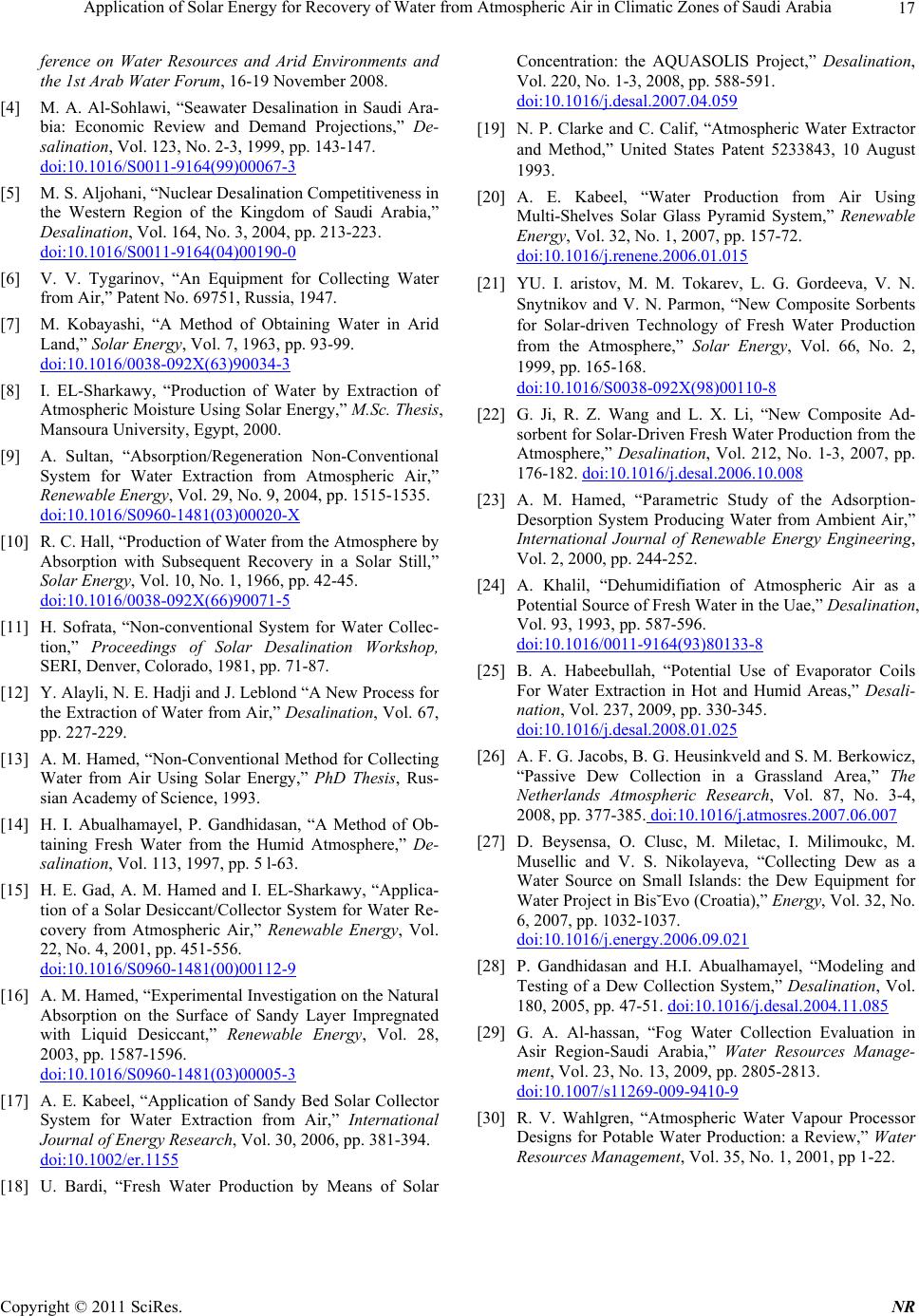
Application of Solar Energy for Recovery of Water from Atmospheric Air in Climatic Zones of Saudi Arabia
Copyright © 2011 SciRes. NR
17
ference on Water Resources and Arid Environments and
the 1st Arab Water Forum, 16-19 November 2008.
[4] M. A. Al-Sohlawi, “Seawater Desalination in Saudi Ara-
bia: Economic Review and Demand Projections,” De-
salination, Vol. 123, No. 2-3, 1999, pp. 143-147.
doi:10.1016/S0011-9164(99)00067-3
[5] M. S. Aljohani, “Nuclear Desalination Competitiveness in
the Western Region of the Kingdom of Saudi Arabia,”
Desalination, Vol. 164, No. 3, 2004, pp. 213-223.
doi:10.1016/S0011-9164(04)00190-0
[6] V. V. Tygarinov, “An Equipment for Collecting Water
from Air,” Patent No. 69751, Russia, 1947.
[7] M. Kobayashi, “A Method of Obtaining Water in Arid
Land,” Solar Energy, Vol. 7, 1963, pp. 93-99.
doi:10.1016/0038-092X(63)90034-3
ic Moisture Using Solar Energy,” M.Sc. Thesis
Mansoura University, Egypt, 2000.
(03)00020-X
[8] I. EL-Sharkawy, “Production of Water by Extraction of
Atmospher ,
[9] A. Sultan, “Absorption/Regeneration Non-Conventional
System for Water Extraction from Atmospheric Air,”
Renewable Ener gy, Vol. 29, No. 9, 2004, pp. 1515-1535.
doi:10.1016/S0960-1481
ater from the Atmosphere by
t Recovery in a Solar Still,”
[10] R. C. Hall, “Production of W
Absorption with Subsequen
Solar Energy, Vol. 10, No. 1, 1966, pp. 42-45.
doi:10.1016/0038-092X(66)90071-5
[11] H. Sofrata, “Non-conventional System for Water Collec-
tion,” Proceedings of Solar Desalination Workshop,
SERI, Denver87.
[12] Y. Alayli, N. E. ew Process for
cting
PhD Thesis, Rus
el, P. Gandhidasan, “A Method of Ob-
, Colorado, 1981, pp. 71-
Hadji and J. Leblond “A N
the Extraction of Water from Air,” Desalination, Vol. 67,
pp. 227-229.
[13] A. M. Hamed, “Non-Conventional Method for Colle
Water from Air Using Solar Energy,”-
sian Academy of Science, 1993.
[14] H. I. Abualhamay
taining Fresh Water from the Humid Atmosphere,” De-
salination, Vol. 113, 1997, pp. 5 l-63.
[15] H. E. Gad, A. M. Hamed and I. EL-Sharkawy, “Applica-
tion of a Solar Desiccant/Collector System for Water Re-
covery from Atmospheric Air,” Renewable Energy, Vol.
22, No. 4, 2001, pp. 451-556.
doi:10.1016/S0960-1481(00)00112-9
[16] A. M. Hamed, “Experimental Investigation on the Natural
Absorption on the Surface of Sandy Layer Impregnated
with Liquid Desiccant,” Renewable Energy, Vol. 28,
2003, pp. 1587-1596.
doi:10.1016/S0960-1481(03)00005-3
[17] A. E. Kabeel, “Application of Sandy Bed Solar Collector
System for Water Extraction from Air,” International
Journal of Energy Research, Vol. 30, 2006, pp. 381-394.
doi:10.1002/er.1155
[18] U. Bardi, “Fresh Water Production by Means of Solar
Concentration: the AQUASOLIS Project,” Desalination,
Vol. 220, No. 1-3, 2008, pp. 588-591.
doi:10.1016/j.desal.2007.04.059
[19] N. P. Clarke and C. Calif, “Atmospheric Water Extractor
ir Using
ystem,” Renewable
and Method,” United States Patent 5233843, 10 August
1993.
[20] A. E. Kabeel, “Water Production from A
Multi-Shelves Solar Glass Pyramid S
Energy, Vol. 32, No. 1, 2007, pp. 157-72.
doi:10.1016/j.renene.2006.01.015
[21] YU. I. aristov, M. M. Tokarev, L. G. Gordeeva, V. N.
Snytnikov and V. N. Parmon, “New Composite Sorbents
for Solar-driven Technology of Fresh Water Production
from the Atmosphere,” Solar Energy, Vol. 66, No. 2,
1999, pp. 165-168.
doi:10.1016/S0038-092X(98)00110-8
G. Ji, R. Z. Wang and L. X. L[22] i, “New Composite Ad-
sorbent for Solar-Driven Fresh Water Production from the
Atmosphere,” Desalination, Vol. 212, No. 1-3, 2007, pp.
176-182. doi:10.1016/j.desal.2006.10.008
[23] A. M. Hamed, “Parametric Study of the Adsorption-
Desorption System Producing Water from Ambient Air,”
International Journal of Renewable Energy Engineering,
Vol. 2, 2000, pp. 244-252.
A. Khalil, “Dehumidifiation of Atm[24] ospheric Air as a
Potential Source of Fresh Water in the Uae,” Desalination,
Vol. 93, 1993, pp. 587-596.
doi:10.1016/0011-9164(93)80133-8
[25] B. A. Habeebullah, “Potential Use o
For Water Extraction in Hot and Hum
f Evaporator Coils
id Areas,” Desali-
nation, Vol. 237, 2009, pp. 330-345.
doi:10.1016/j.desal.2008.01.025
[26] A. F. G. Jacobs, B. G. Heusinkveld and S. M. Berkowicz,
“Passive Dew Colle
ction in a Grassland Area,” The
Netherlands Atmospheric Research, Vol. 87, No. 3-4,
2008, pp. 377-385. doi:10.1016/j.atmosres.2007.06.007
[27] D. Beysensa, O. Clusc, M. Miletac,
Musellic and V. S. Nikolayeva,
I. Milimoukc, M.
“Collecting Dew as a
, pp. 1032-1037.
Water Source on Small Islands: the Dew Equipment for
Water Project in Bis˘Evo (Croatia),” Energy, Vol. 32, No.
6, 2007
doi:10.1016/j.energy.2006.09.021
[28] P. Gandhidasan and H.I. Abualhamayel, “Modeling and
Testing of a Dew Collection System,” Desa
180, 2005, pp. 47-51.
lination, Vol.
.desal.2004.11.085doi:10.1016/j
[29] G. A. Al-hassan, “Fog Water Collection Evaluation in
Asir Region-Saudi Arabia,” Water Resources Manage-
ment, Vol. 23, No. 13, 2009, pp. 2805-2813.
doi:10.1007/s11269-009-9410-9
[30] R. V. Wahlgren, “At
Designs for Potable Water Production:
mospheric Water Vapour Processor
a Review,” Water
Resources Management, Vol. 35, No. 1, 2001, pp 1-22.